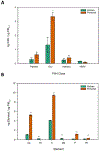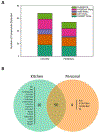Workflow for Comparison of Chemical and Biological Metrics of Filter Collected PM2.5
- PMID: 32313426
- PMCID: PMC7170255
- DOI: 10.1016/j.atmosenv.2020.117379
Workflow for Comparison of Chemical and Biological Metrics of Filter Collected PM2.5
Abstract
There is limited understanding of adverse health effect associations with chemical constituents of fine particulate matter (PM2.5) as well as the underlying mechanisms. We outlined a workflow to assess metrics, beyond concentration, using household and personal PM2.5 filter samples collected in India as a proof of concept for future large-scale studies. Oxidative potential, chemical composition (polycyclic aromatic hydrocarbons and elements), and bioactivity (developmental exposures in zebrafish) were determined. Significant differences were observed in all metrics between personal and household PM2.5 samples. This work established methods to characterize multiple metrics of PM2.5 to ultimately support the identification of more health-relevant metrics than concentration.
Keywords: Household air pollution; Indoor PM2.5; PAH diagnostic ratios; PM2.5 composition; oxidative potential; zebrafish.
Conflict of interest statement
Declaration of interests The authors declare that they have no known competing financial interests or personal relationships that could have appeared to influence the work reported in this paper. The authors declare the following financial interests/personal relationships which may be considered as potential competing interests:
Figures





References
-
- Household air pollution and health https://www.who.int/news-room/fact-sheets/detail/household-air-pollution... (accessed Oct 30, 2019).
-
- Liao J; Zimmermann Jin A; Chafe ZA; Pillarisetti A; Yu T; Shan M; Yang X; Li H; Liu G; Smith KR The Impact of Household Cooking and Heating with Solid Fuels on Ambient PM 2.5 in Peri-Urban Beijing. Atmos. Environ 2017, 165, 62–72. 10.1016/j.atmosenv.2017.05.053. - DOI
Grants and funding
LinkOut - more resources
Full Text Sources
